With topics ranging from soil erosion to dieters’ eating patterns to radiation therapy, 49 graduate students presented their research to faculty members, their peers, and others in the Dartmouth community during this year’s Graduate Poster Session. The event was part of the annual Graduate Student Appreciation Week, held April 6 through 10.

Awards were presented to five graduate students for their posters. They are:
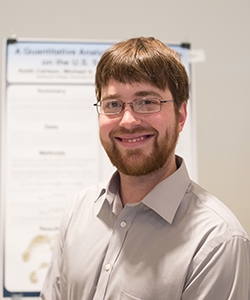
Keith Carlson (Photo by Eli Burakian ’00)
Keith Carlson, Computer Science
Hometown: Meadville, Pa.
Poster Title: A Quantitative Analysis of Writing Style on the U.S. Supreme Court
Research: “My research interests involve trying to understand culture through a computational lens. With cultural data being generated and released at an increasing rate, we have opportunities to see how culture develops and is transmitted through different mediums.”
Why Dartmouth: “Dartmouth is a great fit for me. Great research is being done in every field, and I love being surrounded by such diverse innovation.”
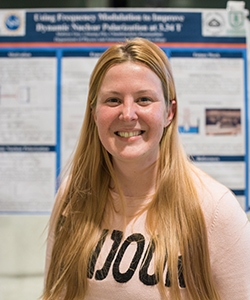
Mallory Guy (Photo by Eli Burakian ’00)
Mallory Guy, Physics and Astronomy
Hometown: Danbury, Conn.
Poster Title: Using Frequency Modulation to Improve Dynamic Nuclear Polarization at 3.3 T
Research: “In the Ramanathan lab at Dartmouth, we use nuclear magnetic resonance (NMR) to study the microscopic world of electrons and nuclei. For my project, we are interested in developing techniques to improve the sensitivity of NMR by understanding how to control the interaction of these electrons and nuclei.
To improve the sensitivity of NMR, we use a technique called Dynamic Nuclear Polarization (DNP). DNP relies on applying microwaves to our sample at a particular frequency. In a typical DNP experiment, microwaves are applied at a constant, single frequency, but we are investigating the effect of varying the frequency of the microwaves we apply. This results in an increased efficiency of the DNP process, and that results in an enhanced NMR signal. We hope to push this signal enhancement closer to the theoretical limit by engineering more-intelligent microwave irradiation schemes. Doing so would mean that the class of samples we are able to study using NMR can be widened, and we could investigate truly novel systems, such as thin films and surfaces.”
Why Dartmouth: “When I came to Dartmouth for the prospective student visitation day, it was the first week of April, and it was snowing outside. Despite the gloomy weather, Dartmouth was still extremely appealing to me. The size of the campus and the physics department made me feel at ease. The professors seemed (and proved to be) very approachable. Additionally, Dartmouth’s focus on teaching fit my interests very well.”
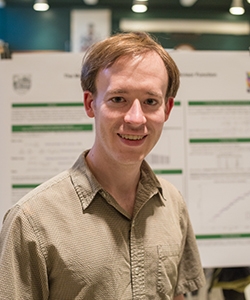
Nathan McNew (Photo by Eli Burakian ’00)
Nathan McNew, Mathematics
Hometown: Arvada, Colo.
Poster Title: The Most Popular Values of the Largest Prime Divisor Function
Research: “I study subsets of the integers that have some property, like being a prime number or being divisible by lots of small prime numbers. Usually we want to know the answers to questions like, ‘How many integers have this property?’ or, ‘How large can the set be before it is forced to have a property?’ The answers to these questions have applications to cryptography, keeping your information secure on the Internet, for example.”
Why Dartmouth: “The math department does a great job of providing opportunities for research with amazing faculty members while also supporting graduate students to become excellent teachers. The scenery of the Upper Valley is a nice bonus.”
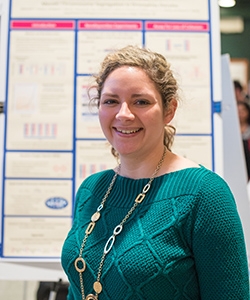
Adrienne Tarver Perkins (Photo by Eli Burakian ’00)
Adrienne Tarver Perkins, Biology
Hometown: Geneseo, Ill.
Poster Title: The Effect of Oxidative Stress on Meiotic Chromosome Segregation in Drosophila Oocytes
Research: “I study what makes a woman’s biological clock tick. In a woman’s 30s her chance of having a miscarriage or a baby with birth defects increases exponentially. This happens when an error occurs during the cell division that creates the egg whereby the egg receives the incorrect number of chromosomes. My research investigates the steps that go awry in this process. Specifically, I’m interested in how oxidative chemicals within the cell can cause loss of protein linkages between the chromosomes and cause them to be unequally partitioned into the egg.”
Why Dartmouth: “I chose Dartmouth because of the multitude of research in different fields and for the community it offers to its graduate students. There is a nice work-life balance here and that makes happy grad students. Dartmouth has a good program for professional and academic development as well as student-organized groups that plan fun outings and get-togethers that help with stress relief.”
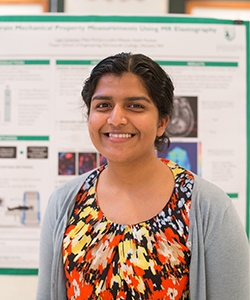
Ligin Merlin Solamen (Photo by Eli Burakian ’00)
Ligin Merlin Solamen, Thayer School of Engineering
Hometown: Orland Park, Ill.
Poster Title: Brain Mechanical Property Measurements Using MR Elastography
Research: “I work on developing a technique called Magnetic Resonance Elastography (MRE). MRE is a medical imaging method that quantifies mechanical properties in tissue. We study the differences between normal and diseased human brain and the mechanical changes that occur in neuropathological diseases such as hydrocephalus, multiple sclerosis, Alzheimer’s disease and brain tumors.”
Why Dartmouth: “Thayer continues to impress me with its innovative research. It is one of the few schools that focus on bridging the gap between engineering and clinical medicine.”
